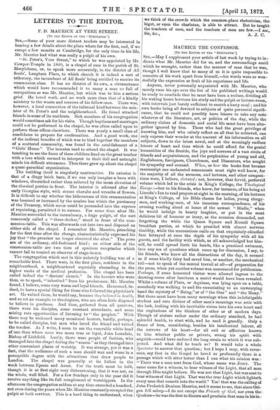LETTERS TO THE EDITOR.
F. D. MAURICE AT VERB STREET.
[TO THE EDITOR OF THS "SPECTATOR.")
Sin,—Some of your more distant readers may be interested in hearing a few details about the place where for the first, and, if we except a few months at Cambridge, for the only time in his life, Mr. Maurice had what was really a pulpit of his own.
"St. Peter's, Vera Street," to which he was appointed by Mr. Cowper-Temple in 1860, is a chapel of ease in the parish of St. Marylebone, or to speak more accurately, in the district of All Souls', Langham Place, to which church it is indeed a sort of tributary, the incumbent of All Souls' being entitled to receive its communion alms. It has no district of its own, a circumstance which would have recommended it to many a man so full of occupations as was Mr. Maurice, but which was to him a serious grief. He loved work, and no work more than that of a kindly ministry to the wants and sorrows of his fellow-men. There was, however, a local connection of the informal kind between the min- ister of St. Peter's and the neighbourhood. He found attached friends in some of its residents. Sick members of his congregation would sometimes ask for his visits. Though baptisms and marriages could not be performed in the chapel, he was often called upon to perform these offices elsewhere. There was yearly a small class of candidates to prepare for confirmation. And a good work, one of the indirect benefits of which was to bind together the members of a scattered community, was found in the establishment of a "Girls' Home." The inmates used to attend the chapel. It was touching to see the faces of these children fixed on the great teacher with a love which seemed to interpret to their dull and untaught minds his difficult utterances. Thus there grew up about the chapel a quasi-parochial organization.
The building itself is singularly unattractive. Its exterior is that of a dingy brick barn, if we can only imagine a barn with windows, diversified rather than relieved by the mean elevation of the classical portico in front. The interior is adorned after the early Georgian style, with stucco cherubs and wreaths of flowers. It is difficult to say whether the hideousness of this ornamentation was lessened or increased by the sombre hue which the parsimony of the Treasury, which never could be persuaded into the expense of repainting, permitted it to assume. For some time after Mr. Maurice succeeded to the incumbency, a huge pulpit, of the sort commonly called a "three-decker," stood in front of the com- munion-table. This was afterwards cut into two and disposed on either side of the chapel. I remember Mr. Maurice, preaching for the first time after the change, characteristically expressed his joy that "the preacher no longer obscured the altar." The pews are of the ordinary, old-fashioned kind ; on either side of the communion-table are two tiers of spacious receptacles which cannot fail to remind an observer of stage-boxes.
The congregation which met in this unlovely building was of a remarkable kind. There were, in the first place, residents in the neighbourhood, a neighbourhood especially abounding in the higher ranks of the medical profession. The chapel has been called indeed the "doctors' church." In the hearers who were thus, so to speak, " inherited " from his predecessor, Mr. Maurice found, I believe, some very warm and loyal friends. He seemed, in- deed, to have a special liking for those who followed the physician's art. He valued them, he would say, because they believed in health, and so set an example to theologians, who are often little disposed to believe in goodness. And then, gathered from all quarters, there were his disciples, some constant attendants, and some seizing rare opportunities of listening to 'the prophet." With these may be reckoned many occasional hearers, hardly, perhaps, to be called disciples, but men who loved the friend and valued the teacher. As I write, I seem to see the venerable white head of one than whom none was more true or loyal, John Lonsdale, Bishop of Lichfield. Lastly, there were people of fashion, who thronged into the chapel during the "season "as they thronged into other convenient places of worship. It was strange, yet it was a fact, that the audiences of such a man should wax and wane in a perceptible degree with the attractions that draw people to London. The chapel was generally at its fullest in the week between Epsom and Ascot. For the truth must be told, though it is at first sight very disheartening, that it was not, on the whole, well filled. For a few Sundays only in the year did it receive anything like its full complement of worshippers. In the afternoon the congregation seldom at any time exceeded a hundred, not even during the years when Mr. Maurice constantly occupied the pulpit at both services. This is a hard thing to understand, when
we think of the crowds which the common-place rhetorician, the bigot, or even the charlatan, is able to attract. But he taught the teachers of men, and the teachers of men are few.—! am,.


































 Previous page
Previous page